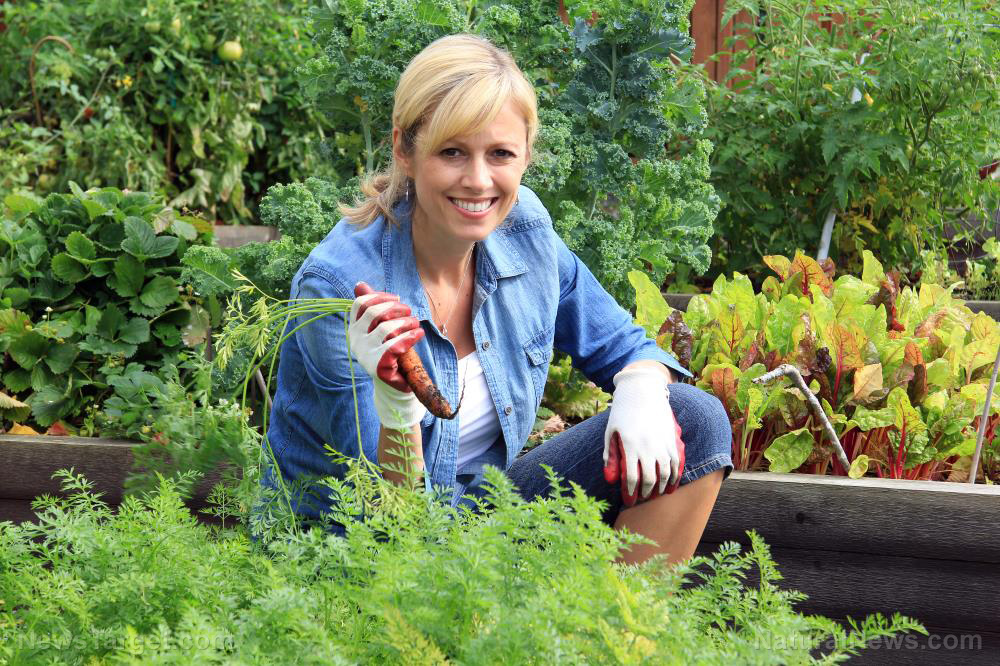Home remedies for preppers: 5 Medicinal plants for wound healing
11/01/2022 / By Zoey Sky

Before modern medicine, people used medicinal plants for wound healing. Preppers can benefit from knowing which medicinal plants can be used to treat wounds.
Prepare before SHTF by learning about some common plants that can be used to disinfect and heal wounds, like calendula and echinacea. You can either forage for the plants below, or you can grow them right in your home garden. (h/t to AskAPrepper.com)
Calendula
Calendula is a plant that bears brightly colored flowers with wound-healing abilities. It can also be used to help treat viral infections and stomach pain.
Calendula has been used for wound healing and for treating burns, cuts, scratches and even deep-open wounds.
Data suggests that calendula can help wounds heal faster. Experts think that this is because the plant helps increase blood flow and oxygen to the damaged tissues, which helps the natural processes of the immune system heal them more efficiently. (Related: Gardening tips for preppers: How to start a medicinal herb garden.)
Calendula also helps prevent the overgrowth of bacteria. This helps keep any infections at bay while your wounds are healing.
Using calendula for wound healing
To heal wounds with calendula, harvest the flowers and petals. Try to collect the flowers during summer when they are at their medicinal peak.
Fresh or dried calendula flowers can be used for these recipes:
Cream
To make a soothing calendula cream for burns and insect bites, infuse calendula flowers in some oil and add coconut oil and a little bit of beeswax using a blender. This emulsifies the cream and gives it a soft and airy texture.
Salve
Make calendula salve by infusing the flowers in some oil and adding beeswax. Pour the mixture into a small tin container and use the salve to treat wounds on the go.
Tincture
Make calendula tincture by grinding dried flowers to a powder and adding distilled water and 80+ proof alcohol in a small jar. Let the mixture sit for six weeks.
You can use the tincture internally or topically. Mix a few drops of the tincture in water to create a rinse that can help disinfect wounds.
Echinacea
Echinacea grows in North America and it has been used by Native Americans for hundreds of years as a natural “cure-all.”
Echinacea bears beautiful tall pink or purple flowers with a central cone where it stores seeds. The plant grows in many gardens and in the wild.
Echinacea can help boost your immune system, treat colds and viruses and treat slow-healing wounds. It is also commonly consumed as a tea that helps shorten the duration of a cold.
Echinacea is also used for wound healing, especially wounds that persist.
Echinacea plants contain different active compounds like alkamides, caffeic acid, phenolic acids, polyacetylenes, rosmarinic acid and more. Research also suggests that the compounds in echinacea are linked to many health benefits like improved immunity, reduced inflammation and lower blood sugar levels.
When using echinacea to treat cuts, harvest the upper part of the plant except the roots because that’s where most of the wound-healing compounds are stored.
Use echinacea plant to treat burns, cuts, scrapes, insect bites and snake bites. The plant has antibacterial, antifungal, antiseptic and antiviral properties, so it can help prevent serious infections at the site of the wound.
The plant also helps increase the activity of your immune system, which helps speed up healing. Echinacea also decreases inflammation, which helps reduce discomfort.
Using echinacea for wound healing
The flowers, leaves and stems of the plant can be used to make home remedies. While the roots can also be used, they are more effective against colds and flu.
Paste
An echinacea paste is similar to a poultice. You can make the paste immediately after harvesting and apply it directly to your wounds.
Pick fresh leaves from the plant, blend them up and apply the paste over your wounds. If you don’t have access to a blender, chew the leaves to make the paste.
Poultice
You can also use an echinacea and honey poultice to treat wounds.
Use dried ground-up echinacea leaves and mix them with an equal part of Manuka honey, then apply the poultice directly over the wound.
Salve
Infuse dried echinacea leaves and flowers in some oil, add beeswax and pour into a small tin to make a portable salve for treating wounds on the go.
Garlic
Garlic is an effective herb for killing bacteria and inducing quicker wound healing. Garlic contains allicin, a beneficial compound that has been the topic of many studies.
Research has found that allicin has antimicrobial and anti-inflammatory properties. Data also shows that allicin activates fibroblasts or special types of cells found in your body that contribute to the formation of connective tissues.
Garlic helps increase the proliferation of fibroblasts in affected areas when applied topically. You can also take garlic internally to help fight various colds and bugs.
All parts of the garlic plant contain healing compounds, but most of them are stored in the bulb.
Using garlic for wound healing
Garlic is best used fresh, but you can also use garlic powder made of dried and ground-up garlic cloves.
Fresh cloves
If you have fresh garlic cloves, cut a fresh clove and rub the cut side over your wound.
Paste
Make a paste with fresh garlic cloves by blending them with a little bit of oil in a blender. If you don’t have access to a blender, chew up the garlic.
Apply the paste directly to a wound and put gauze over it to keep it in place.
Poultice
Increase the healing effects of garlic paste by adding a tablespoon of manuka honey. This creates a healing poultice.
Apply the garlic poultice the same way you would apply the paste.
Marshmallow root
The marshmallow plant is a tall upright perennial with delicate pale pink flowers. The plant originated in coastal areas of Europe, but it is now widely naturalized and can be found on almost every continent.
Marshmallow is a common herb that grows in many gardens across North America. It has been used as an herbal remedy and as a vegetable in times of need.
To treat wounds, you need marshmallow root. It helps speed up tissue repair, minimize inflammation and prevent infections.
Marshmallow root can also help address skin rashes or other inflammations because of its soothing quality.
Marshmallow root contains mucilage. When mixed with warm water, mucilage turns into a thick gel that you can apply directly to your skin to induce healing effects.
The gel dries into a sort of adhesive that protects the wound from contaminants and acts as a natural Band-Aid.
Using marshmallow root for wound healing
After harvesting marshmallow root, cut it up and let it dry.
After the roots have dried, grind them up to use for the following recipes:
Poultice
Mix dried and ground-up marshmallow roots with an equal part of boiling water. Mix the ingredients until they become jelly-like. Apply the marshmallow poultice directly to your wounds.
Salve
Infuse dried marshmallow root in oil and melt some beeswax into the mixture. Pour the salve into a small tin and use as needed.
Slippery elm
Slippery elm is a common tree in North America and it has been used for medicinal purposes for thousands of years by Native Americans.
The tree can be found growing in the eastern part of the country. Slippery elm trees can grow up to 70 to 90 feet tall.
The trees have hairy and deeply-veined leaves. Use the leaves to make poultices that can help heal wounds and encourage healing.
Slippery elm bark can also be used to treat topical ailments.
Like marshmallow root, slippery elm bark also contains mucilage, which is instrumental to healing. It can be used on cuts, scrapes, boils, burns, and other forms of skin inflammation.
Using slippery elm for wound healing
Harvest and use fresh leaves from the tree. When harvesting the bark, pick a few branches about two inches in diameter from the lower section of the tree and pull away the bark. If the tree is healthy, the branch should pull away easily.
You can dry slippery elm bark for later use.
Bark poultice
Mix dried and ground bark with an equal part of warm water and mix until the liquid has a gel-like consistency. Apply the bark poultice directly to the wound.
Leaf poultice
If you get hurt when SHTF, create a poultice out of slippery elm leaves by chewing them up and applying the paste over your wounds. You can also use a blender to make a poultice.
Tea
To make slippery elm tea, soak the bark in hot water for five to 10 minutes. However, instead of drinking the tea, you need to take a clean cloth, soak it in the tea and wrap it around the wounded area.
When SHTF, forage for plants like calendula or echinacea or grow them in your home garden so you can treat wounds using these medicinal plants.
Watch the video below to know how to use echinacea to treat colds and the flu.
This video is from the Holistic Herbalist channel on Brighteon.com.
More related stories:
Natural healing: The medicinal benefits of cayenne pepper.
Natural healing: Medicinal plants you can find in various regions of North America.
Medicinal plants: The survival uses of gumweed.
Sources include:
Submit a correction >>
Tagged Under:
alternative medicine, calendula, Echinacea, emergency medicine, garlic, green living, herbal medicine, Herbs, homesteading, Marshmallow Root, natural cures, natural medicine, preparedness, prepper, prepping, remedies, Slippery elm, survival, survival medicine, Wound Healing
This article may contain statements that reflect the opinion of the author
RECENT NEWS & ARTICLES
SurvivalMedicine.News is a fact-based public education website published by Survival Medicine News Features, LLC.
All content copyright © 2018 by Survival Medicine News Features, LLC.
Contact Us with Tips or Corrections
All trademarks, registered trademarks and servicemarks mentioned on this site are the property of their respective owners.




















